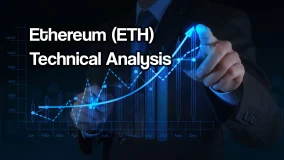Table of Contents
What is Ethereum The Merge Update? What Will Change?
The first step of the long-awaited Ethereum Merge update has been taken. With the update, all developments about Ethereum Merge, which aims to exhibit an environmentalist approach, negative effects waiting for miners, and more are with you...

The day the crypto world has been waiting for years is approaching: the reform of the Ethereum blockchain, the data protocol of the second largest cryptocurrency after Bitcoin, will take place in September. In the future, new cryptocurrencies will no longer be created based on the proof-of-work process but rather based on the proof-of-stake process.
Merge, which appears to be just an update for developer enthusiasts, actually has significant implications for the crypto industry. With the change (also called consolidation), Ethereum is expected to be greener, faster, and cheaper. Many investors think that the ether currency will benefit from this. The exchange rate had already increased significantly earlier. But what does defragmentation mean and what are its advantages and disadvantages? The most important questions and answers:
What is Ethereum Merge Update?
The transition of the Ethereum blockchain from the Proof of Work consensus procedure to the Proof of Stake consensus procedure is called Ethereum consolidation. This means that the Ethereum Foundation has developed a new blockchain that follows the Proof of Stake system for the past few years. This will be merged with the legacy Proof-of-Work blockchain in September.
Why Is Ethereum Consolidating?
Consolidation is a system developed to allow transactions to be made faster on the blockchain. At the same time, the transition to Proof of Stake reduces pure energy consumption as no miners are needed to guarantee the security of the system. In mining, complex mathematical tasks are solved on high-performance computers. Miners are rewarded with coins. This requires a lot of computing power and therefore a lot of energy.
Unlike Bitcoin, confirmation of a large portion of the Ethereum network will no longer be required for future transactions, only a certain number of validators will be required to stake their Ether deposits – i.e. lend them to secure the network. These contacts are used to verify or deny transactions on the network. This significantly reduces the energy requirement, as the computing power required for verification is significantly reduced. People who lend their shares to the system receive a reward in the form of ether coins.
When Is The Ethereum Merger?
The Ethereum merger is scheduled to happen on September 15 or 16, 2022. Investors and miners are now eagerly waiting to see if the deadline will be met this time. This date has been delayed several times in the past. The transition to Proof of Stake was expected in 2019.
The first phase of Ethereum consolidation was launched with the Bellatrix upgrade on September 6, 2022. With the update that started, trading operations were stopped.
What Advantages Will Ethereum Merge Provide?
By switching to Proof of Stake, the energy requirements of the Ethereum blockchain are significantly reduced, as less computing power is required to verify transactions. After the merger, it is estimated that Ether's energy consumption will decrease by 99 percent.
At the same time, transactions will be processed faster than before as fewer participants verify transactions on the blockchain. Additionally, fees for transactions on the Ethereum blockchain will drop significantly. These are still very high compared to many other cryptocurrencies at the moment. Ether is therefore sometimes considered a “coin for the rich”.
Ethereum in its current form has a scaling issue. With around 15 transactions per second, the performance of the Ethereum blockchain is well below the requirements of the largest smart contract platform. Smart contracts are automatically executable contracts on the blockchain. Many NFT (non-comparable tokens), i.e. immutable tokens and DeFi applications (decentralized finance) are based on the Ethereum blockchain.
The scaling gap can be observed when transaction demands and with them, transaction costs increase. Merging will not directly solve the scaling issue. But it paves the way for subsequent solutions.
What Disadvantages Could Merger On Ethereum Have?
The move to Proof of Stake could make the Ethereum network less secure, as it is no longer secured by miners and their computing power, but by so-called validators. These are the people who lend their ether deposits. People with large deposits can also place more bets and thus have a greater influence within the network. Only those with smaller ether deposits share these stakes through central providers such as Coinbase or Kraken.
This is why some experts fear that individual participants may gain too much influence and power. Additionally, the influence of centralized platforms such as Coinbase or Kraken could increase as they allow small investors to have stakes in the first place.
Is Proof of Work (PoW) Harmful?
Until now, Ethereum, like Bitcoin, was based on the Proof of Work consensus process. This method was often criticized in Europe because it used so much energy and was therefore considered harmful to the climate. The system needs a lot of energy to survive: By providing more computing power, miners increase their chances of processing a block, thereby generating income.
However: Bitcoin needs a lot of energy to offer the highest standard of security - so energy consumption is not a "fault" in the bitcoin blockchain, but fulfills a clear purpose. Proof of Work advocates, therefore, do not talk about consumption when mining Bitcoin, but rather the need for the network to operate in a secure and, above all, decentralized way. Bitcoin miners also use over-generated energy, thus making it more secure.
In addition, 60 percent of the energy required for mining already comes from sustainable energy sources such as wind or solar power. Bitcoin mining, therefore, has the highest sustainable energy resources and thus far exceeds the rate in Germany, the EU, or the US, according to data from the Bitcoin Mining Council. These key points often come to the fore in discussions about proof of work.
How Is The Ethereum Rate Responding To The Impending Merger?
Since the low on June 18, 2022, the price of ether has risen more than 100 percent to around $2000. Ether was last listed at around $1600 (as of 09:41). Therefore, investors are increasingly relying on the upcoming merger in Ethereum, driving the price up. By comparison: Bitcoin has “only” gained 40 percent during this period and is now back below $20,000. Ether is still a long way from the previous record level in November of last year.
That said, it remains exciting to see how the ether course responds to the merger. Miners who have secured the Ethereum network so far can then use their computing power to support another proof-of-work system.
How Can Ethereum Take Advantage of the Classic Merge Update?
Ethereum Classic is another cryptocurrency that uses a slightly different protocol than Ethereum itself. It is effectively a modified Ethereum blockchain that runs in parallel. It was first developed in response to an attack in 2016.
Ethereum Classic wants to stick with the previous Proof-of-Work model. But precisely because of this, many people see some kind of backup fuse in this blockchain if the update is not successful. In any case, since June 18, the price of this coin has risen even more than the price of ether: 183.7 percent.
NFTs can also benefit from the consensus key. Most of the non-exchangeable tokens are based on Ethereum technology. NFTs have also been criticized for being harmful to the climate. Demand could rise due to falling transaction fees: Until now, registering ownership rights in an NFT on the blockchain has been expensive.
Even if the merger of Ether and NFTs could provide positive momentum, the framework conditions in the crypto world are not so good right now: Cryptocurrency prices have been under pressure since the beginning of the year. To curb inflation, central banks gave the good news that the low-interest policy was over. This is a burden for speculative assets like cryptocurrencies because safe investments like bonds become more attractive. It is also questionable to what extent the crypto market is already pricing in a successful merger. In this case, the merger itself would have practically no other price impact.



